Professional Project BUSN20019: Renewable Energy Plan for Australia
VerifiedAdded on 2022/11/29
|14
|2630
|81
Project
AI Summary
This professional project proposal, submitted by Vinith Kumar Proddutur for the BUSN20019 unit, investigates Australian energy usage and the development of a sustainable renewable energy plan. The project aims to analyze energy consumption statistics over the past five years, identify existing and potential renewable energy sources (particularly solar), and assess Australia's capacity for renewable energy generation. The research employs secondary data analysis, focusing on quantitative data from government and other reliable online sources. The proposal includes research questions examining the relationship between energy usage and non-renewable sources, the amount of renewable energy generated, and future generation potential. A detailed literature review supports the research, and a Gantt chart outlines the project schedule. The project's conclusion will offer insights into Australia's energy future and recommendations for sustainable energy practices.
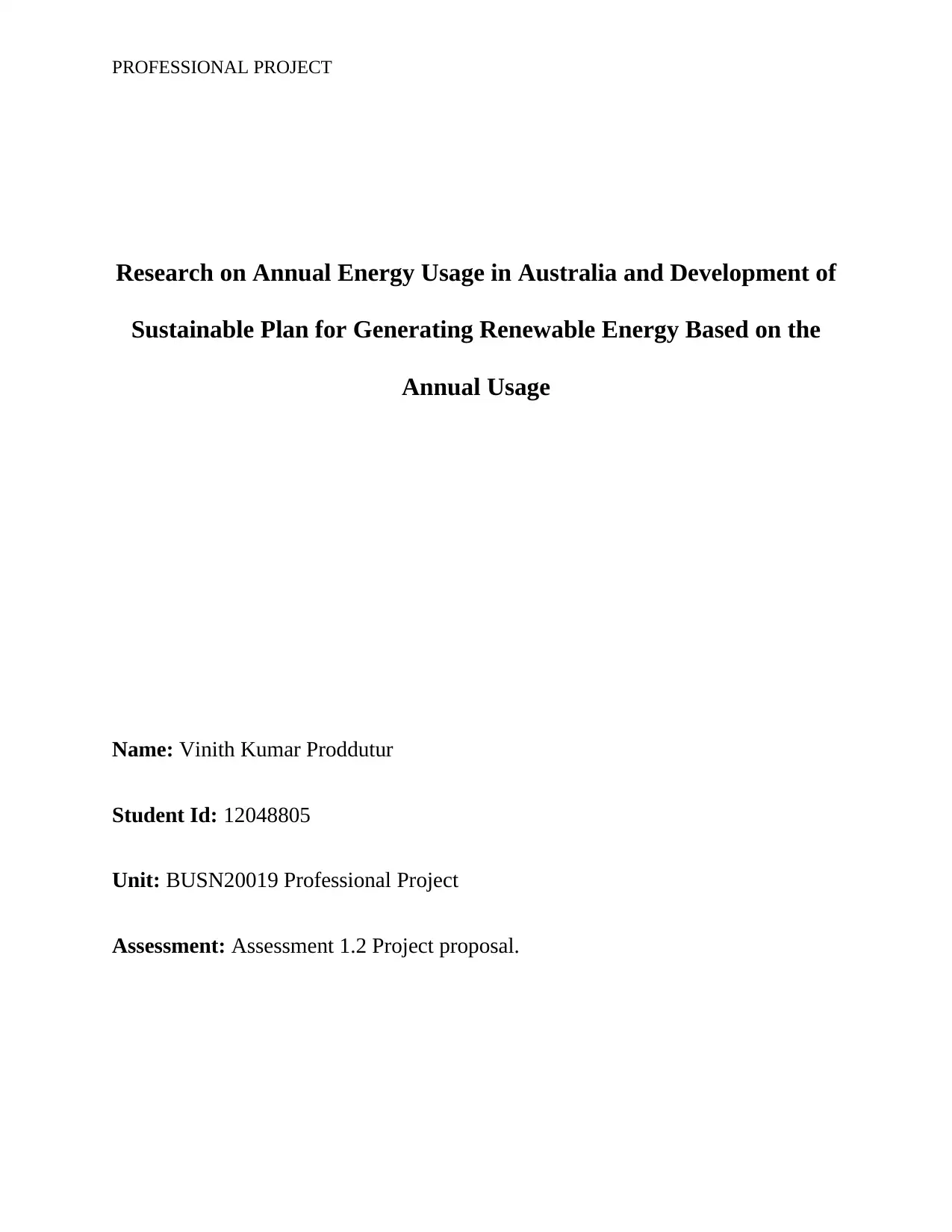
PROFESSIONAL PROJECT
Research on Annual Energy Usage in Australia and Development of
Sustainable Plan for Generating Renewable Energy Based on the
Annual Usage
Name: Vinith Kumar Proddutur
Student Id: 12048805
Unit: BUSN20019 Professional Project
Assessment: Assessment 1.2 Project proposal.
Research on Annual Energy Usage in Australia and Development of
Sustainable Plan for Generating Renewable Energy Based on the
Annual Usage
Name: Vinith Kumar Proddutur
Student Id: 12048805
Unit: BUSN20019 Professional Project
Assessment: Assessment 1.2 Project proposal.
Paraphrase This Document
Need a fresh take? Get an instant paraphrase of this document with our AI Paraphraser
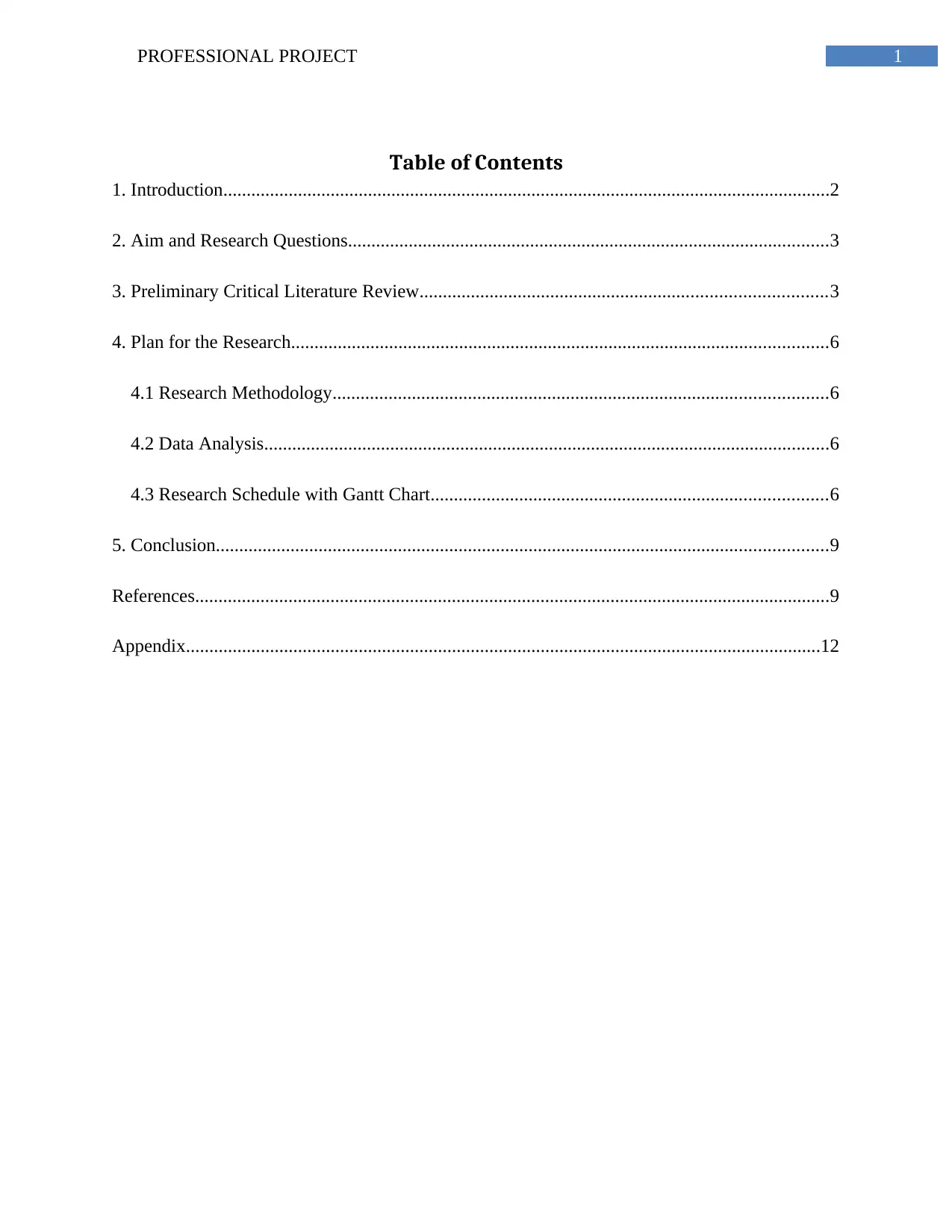
1PROFESSIONAL PROJECT
Table of Contents
1. Introduction..................................................................................................................................2
2. Aim and Research Questions.......................................................................................................3
3. Preliminary Critical Literature Review.......................................................................................3
4. Plan for the Research...................................................................................................................6
4.1 Research Methodology..........................................................................................................6
4.2 Data Analysis.........................................................................................................................6
4.3 Research Schedule with Gantt Chart.....................................................................................6
5. Conclusion...................................................................................................................................9
References........................................................................................................................................9
Appendix........................................................................................................................................12
Table of Contents
1. Introduction..................................................................................................................................2
2. Aim and Research Questions.......................................................................................................3
3. Preliminary Critical Literature Review.......................................................................................3
4. Plan for the Research...................................................................................................................6
4.1 Research Methodology..........................................................................................................6
4.2 Data Analysis.........................................................................................................................6
4.3 Research Schedule with Gantt Chart.....................................................................................6
5. Conclusion...................................................................................................................................9
References........................................................................................................................................9
Appendix........................................................................................................................................12
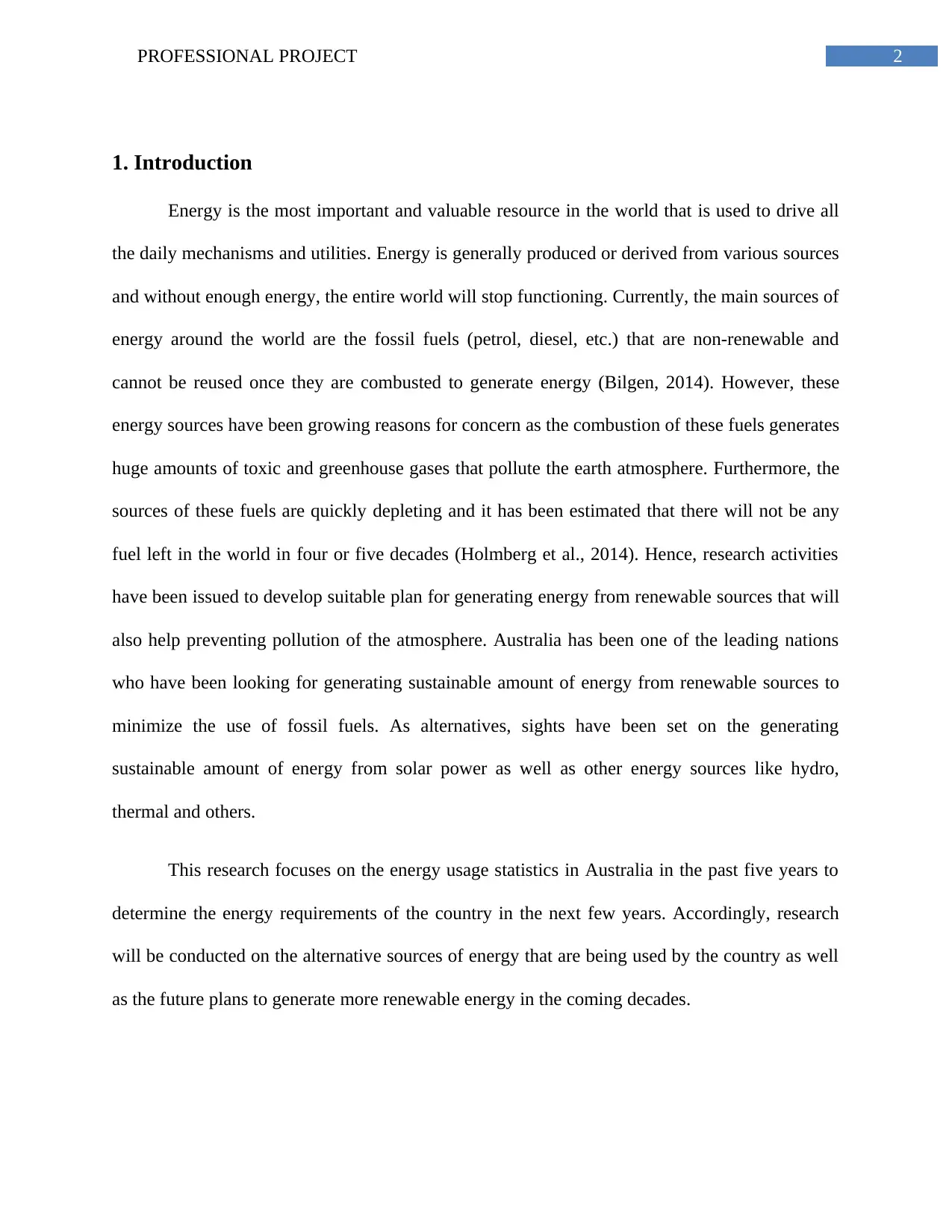
2PROFESSIONAL PROJECT
1. Introduction
Energy is the most important and valuable resource in the world that is used to drive all
the daily mechanisms and utilities. Energy is generally produced or derived from various sources
and without enough energy, the entire world will stop functioning. Currently, the main sources of
energy around the world are the fossil fuels (petrol, diesel, etc.) that are non-renewable and
cannot be reused once they are combusted to generate energy (Bilgen, 2014). However, these
energy sources have been growing reasons for concern as the combustion of these fuels generates
huge amounts of toxic and greenhouse gases that pollute the earth atmosphere. Furthermore, the
sources of these fuels are quickly depleting and it has been estimated that there will not be any
fuel left in the world in four or five decades (Holmberg et al., 2014). Hence, research activities
have been issued to develop suitable plan for generating energy from renewable sources that will
also help preventing pollution of the atmosphere. Australia has been one of the leading nations
who have been looking for generating sustainable amount of energy from renewable sources to
minimize the use of fossil fuels. As alternatives, sights have been set on the generating
sustainable amount of energy from solar power as well as other energy sources like hydro,
thermal and others.
This research focuses on the energy usage statistics in Australia in the past five years to
determine the energy requirements of the country in the next few years. Accordingly, research
will be conducted on the alternative sources of energy that are being used by the country as well
as the future plans to generate more renewable energy in the coming decades.
1. Introduction
Energy is the most important and valuable resource in the world that is used to drive all
the daily mechanisms and utilities. Energy is generally produced or derived from various sources
and without enough energy, the entire world will stop functioning. Currently, the main sources of
energy around the world are the fossil fuels (petrol, diesel, etc.) that are non-renewable and
cannot be reused once they are combusted to generate energy (Bilgen, 2014). However, these
energy sources have been growing reasons for concern as the combustion of these fuels generates
huge amounts of toxic and greenhouse gases that pollute the earth atmosphere. Furthermore, the
sources of these fuels are quickly depleting and it has been estimated that there will not be any
fuel left in the world in four or five decades (Holmberg et al., 2014). Hence, research activities
have been issued to develop suitable plan for generating energy from renewable sources that will
also help preventing pollution of the atmosphere. Australia has been one of the leading nations
who have been looking for generating sustainable amount of energy from renewable sources to
minimize the use of fossil fuels. As alternatives, sights have been set on the generating
sustainable amount of energy from solar power as well as other energy sources like hydro,
thermal and others.
This research focuses on the energy usage statistics in Australia in the past five years to
determine the energy requirements of the country in the next few years. Accordingly, research
will be conducted on the alternative sources of energy that are being used by the country as well
as the future plans to generate more renewable energy in the coming decades.
⊘ This is a preview!⊘
Do you want full access?
Subscribe today to unlock all pages.

Trusted by 1+ million students worldwide
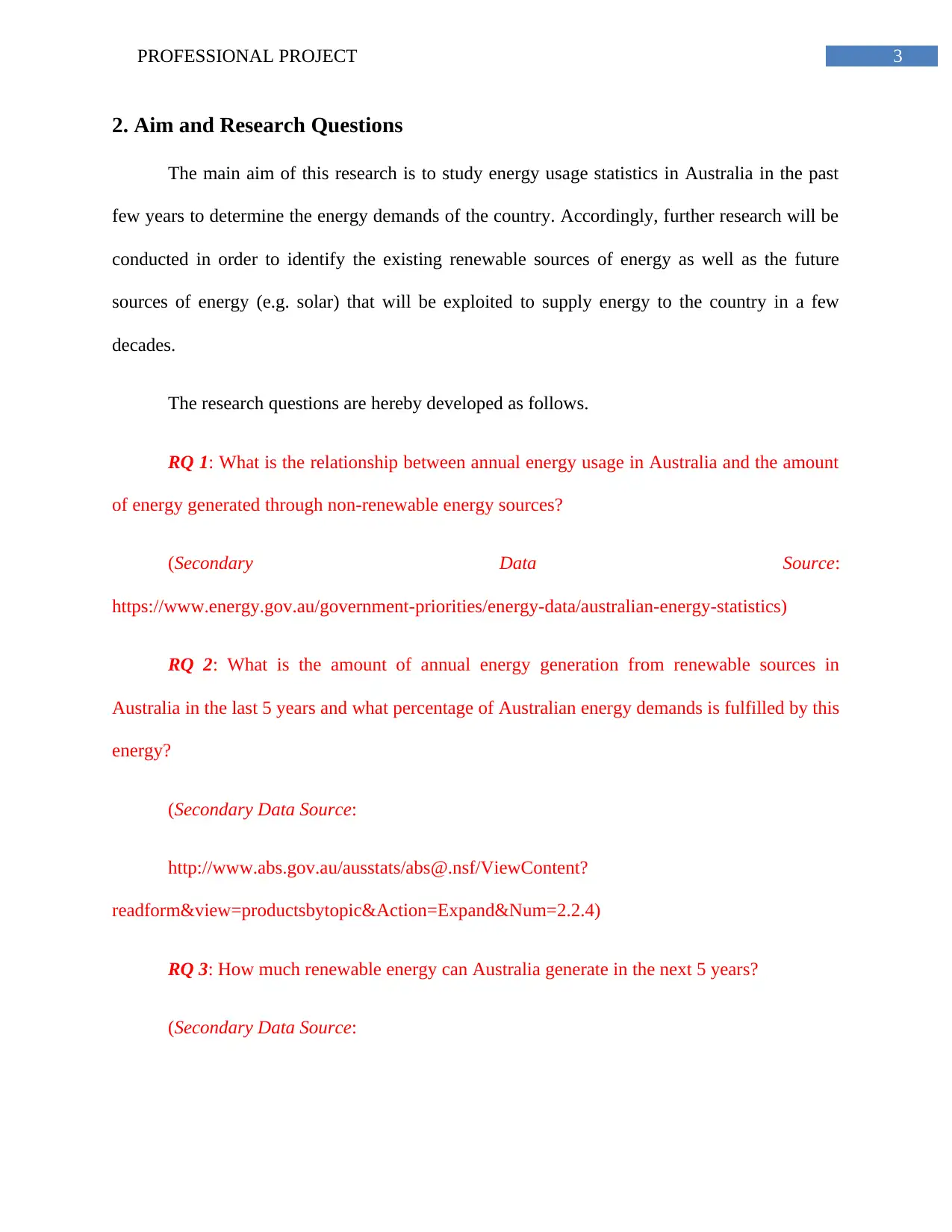
3PROFESSIONAL PROJECT
2. Aim and Research Questions
The main aim of this research is to study energy usage statistics in Australia in the past
few years to determine the energy demands of the country. Accordingly, further research will be
conducted in order to identify the existing renewable sources of energy as well as the future
sources of energy (e.g. solar) that will be exploited to supply energy to the country in a few
decades.
The research questions are hereby developed as follows.
RQ 1: What is the relationship between annual energy usage in Australia and the amount
of energy generated through non-renewable energy sources?
(Secondary Data Source:
https://www.energy.gov.au/government-priorities/energy-data/australian-energy-statistics)
RQ 2: What is the amount of annual energy generation from renewable sources in
Australia in the last 5 years and what percentage of Australian energy demands is fulfilled by this
energy?
(Secondary Data Source:
http://www.abs.gov.au/ausstats/abs@.nsf/ViewContent?
readform&view=productsbytopic&Action=Expand&Num=2.2.4)
RQ 3: How much renewable energy can Australia generate in the next 5 years?
(Secondary Data Source:
2. Aim and Research Questions
The main aim of this research is to study energy usage statistics in Australia in the past
few years to determine the energy demands of the country. Accordingly, further research will be
conducted in order to identify the existing renewable sources of energy as well as the future
sources of energy (e.g. solar) that will be exploited to supply energy to the country in a few
decades.
The research questions are hereby developed as follows.
RQ 1: What is the relationship between annual energy usage in Australia and the amount
of energy generated through non-renewable energy sources?
(Secondary Data Source:
https://www.energy.gov.au/government-priorities/energy-data/australian-energy-statistics)
RQ 2: What is the amount of annual energy generation from renewable sources in
Australia in the last 5 years and what percentage of Australian energy demands is fulfilled by this
energy?
(Secondary Data Source:
http://www.abs.gov.au/ausstats/abs@.nsf/ViewContent?
readform&view=productsbytopic&Action=Expand&Num=2.2.4)
RQ 3: How much renewable energy can Australia generate in the next 5 years?
(Secondary Data Source:
Paraphrase This Document
Need a fresh take? Get an instant paraphrase of this document with our AI Paraphraser
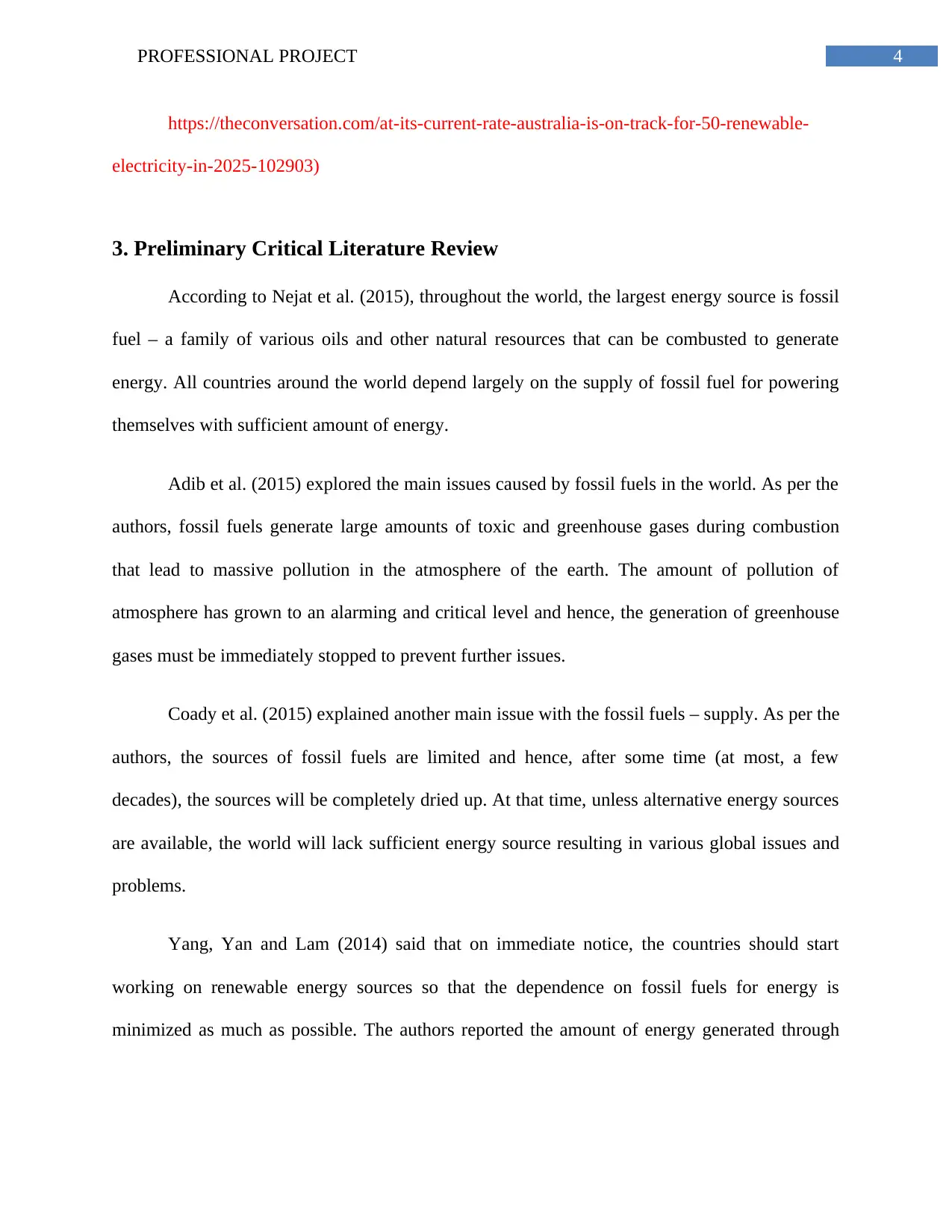
4PROFESSIONAL PROJECT
https://theconversation.com/at-its-current-rate-australia-is-on-track-for-50-renewable-
electricity-in-2025-102903)
3. Preliminary Critical Literature Review
According to Nejat et al. (2015), throughout the world, the largest energy source is fossil
fuel – a family of various oils and other natural resources that can be combusted to generate
energy. All countries around the world depend largely on the supply of fossil fuel for powering
themselves with sufficient amount of energy.
Adib et al. (2015) explored the main issues caused by fossil fuels in the world. As per the
authors, fossil fuels generate large amounts of toxic and greenhouse gases during combustion
that lead to massive pollution in the atmosphere of the earth. The amount of pollution of
atmosphere has grown to an alarming and critical level and hence, the generation of greenhouse
gases must be immediately stopped to prevent further issues.
Coady et al. (2015) explained another main issue with the fossil fuels – supply. As per the
authors, the sources of fossil fuels are limited and hence, after some time (at most, a few
decades), the sources will be completely dried up. At that time, unless alternative energy sources
are available, the world will lack sufficient energy source resulting in various global issues and
problems.
Yang, Yan and Lam (2014) said that on immediate notice, the countries should start
working on renewable energy sources so that the dependence on fossil fuels for energy is
minimized as much as possible. The authors reported the amount of energy generated through
https://theconversation.com/at-its-current-rate-australia-is-on-track-for-50-renewable-
electricity-in-2025-102903)
3. Preliminary Critical Literature Review
According to Nejat et al. (2015), throughout the world, the largest energy source is fossil
fuel – a family of various oils and other natural resources that can be combusted to generate
energy. All countries around the world depend largely on the supply of fossil fuel for powering
themselves with sufficient amount of energy.
Adib et al. (2015) explored the main issues caused by fossil fuels in the world. As per the
authors, fossil fuels generate large amounts of toxic and greenhouse gases during combustion
that lead to massive pollution in the atmosphere of the earth. The amount of pollution of
atmosphere has grown to an alarming and critical level and hence, the generation of greenhouse
gases must be immediately stopped to prevent further issues.
Coady et al. (2015) explained another main issue with the fossil fuels – supply. As per the
authors, the sources of fossil fuels are limited and hence, after some time (at most, a few
decades), the sources will be completely dried up. At that time, unless alternative energy sources
are available, the world will lack sufficient energy source resulting in various global issues and
problems.
Yang, Yan and Lam (2014) said that on immediate notice, the countries should start
working on renewable energy sources so that the dependence on fossil fuels for energy is
minimized as much as possible. The authors reported the amount of energy generated through
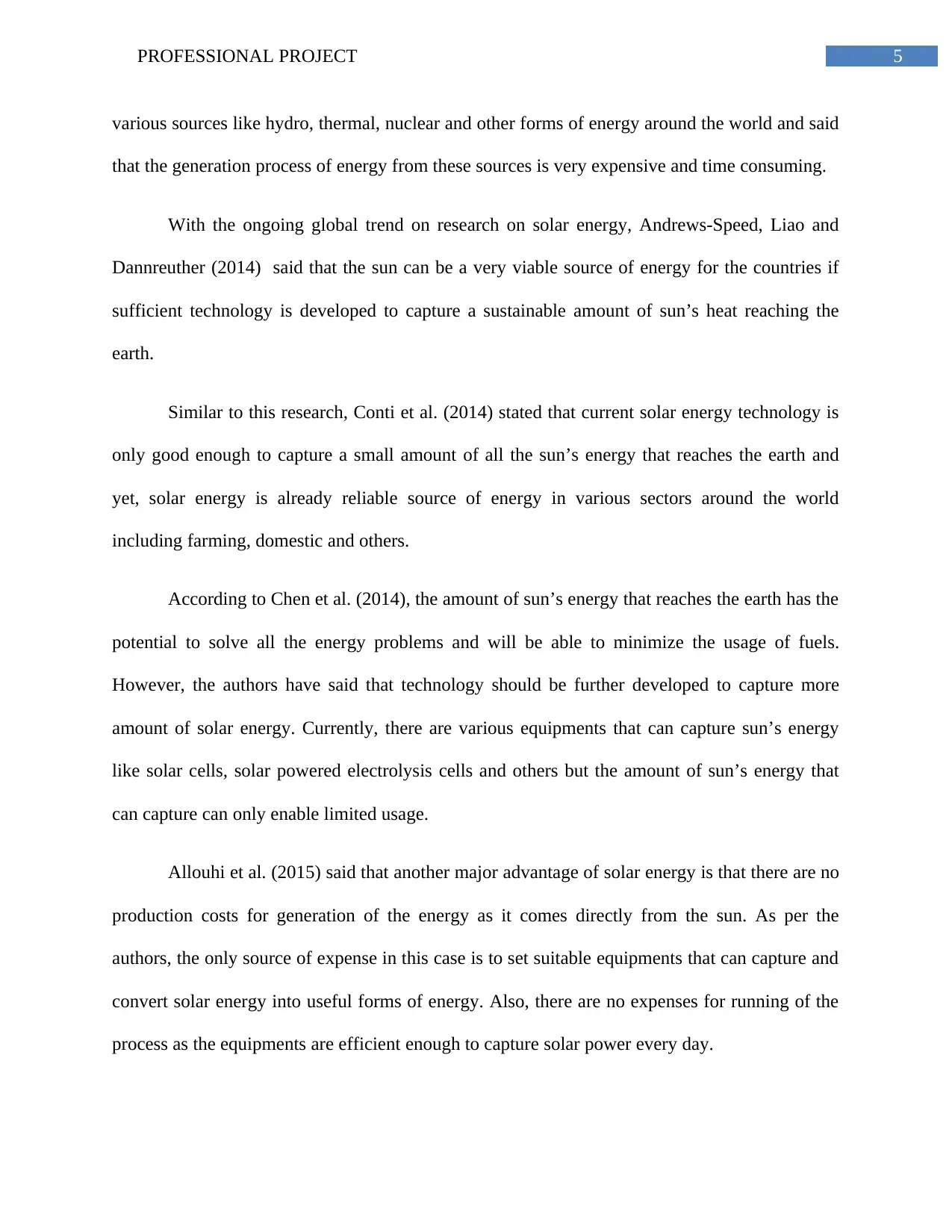
5PROFESSIONAL PROJECT
various sources like hydro, thermal, nuclear and other forms of energy around the world and said
that the generation process of energy from these sources is very expensive and time consuming.
With the ongoing global trend on research on solar energy, Andrews-Speed, Liao and
Dannreuther (2014) said that the sun can be a very viable source of energy for the countries if
sufficient technology is developed to capture a sustainable amount of sun’s heat reaching the
earth.
Similar to this research, Conti et al. (2014) stated that current solar energy technology is
only good enough to capture a small amount of all the sun’s energy that reaches the earth and
yet, solar energy is already reliable source of energy in various sectors around the world
including farming, domestic and others.
According to Chen et al. (2014), the amount of sun’s energy that reaches the earth has the
potential to solve all the energy problems and will be able to minimize the usage of fuels.
However, the authors have said that technology should be further developed to capture more
amount of solar energy. Currently, there are various equipments that can capture sun’s energy
like solar cells, solar powered electrolysis cells and others but the amount of sun’s energy that
can capture can only enable limited usage.
Allouhi et al. (2015) said that another major advantage of solar energy is that there are no
production costs for generation of the energy as it comes directly from the sun. As per the
authors, the only source of expense in this case is to set suitable equipments that can capture and
convert solar energy into useful forms of energy. Also, there are no expenses for running of the
process as the equipments are efficient enough to capture solar power every day.
various sources like hydro, thermal, nuclear and other forms of energy around the world and said
that the generation process of energy from these sources is very expensive and time consuming.
With the ongoing global trend on research on solar energy, Andrews-Speed, Liao and
Dannreuther (2014) said that the sun can be a very viable source of energy for the countries if
sufficient technology is developed to capture a sustainable amount of sun’s heat reaching the
earth.
Similar to this research, Conti et al. (2014) stated that current solar energy technology is
only good enough to capture a small amount of all the sun’s energy that reaches the earth and
yet, solar energy is already reliable source of energy in various sectors around the world
including farming, domestic and others.
According to Chen et al. (2014), the amount of sun’s energy that reaches the earth has the
potential to solve all the energy problems and will be able to minimize the usage of fuels.
However, the authors have said that technology should be further developed to capture more
amount of solar energy. Currently, there are various equipments that can capture sun’s energy
like solar cells, solar powered electrolysis cells and others but the amount of sun’s energy that
can capture can only enable limited usage.
Allouhi et al. (2015) said that another major advantage of solar energy is that there are no
production costs for generation of the energy as it comes directly from the sun. As per the
authors, the only source of expense in this case is to set suitable equipments that can capture and
convert solar energy into useful forms of energy. Also, there are no expenses for running of the
process as the equipments are efficient enough to capture solar power every day.
⊘ This is a preview!⊘
Do you want full access?
Subscribe today to unlock all pages.

Trusted by 1+ million students worldwide
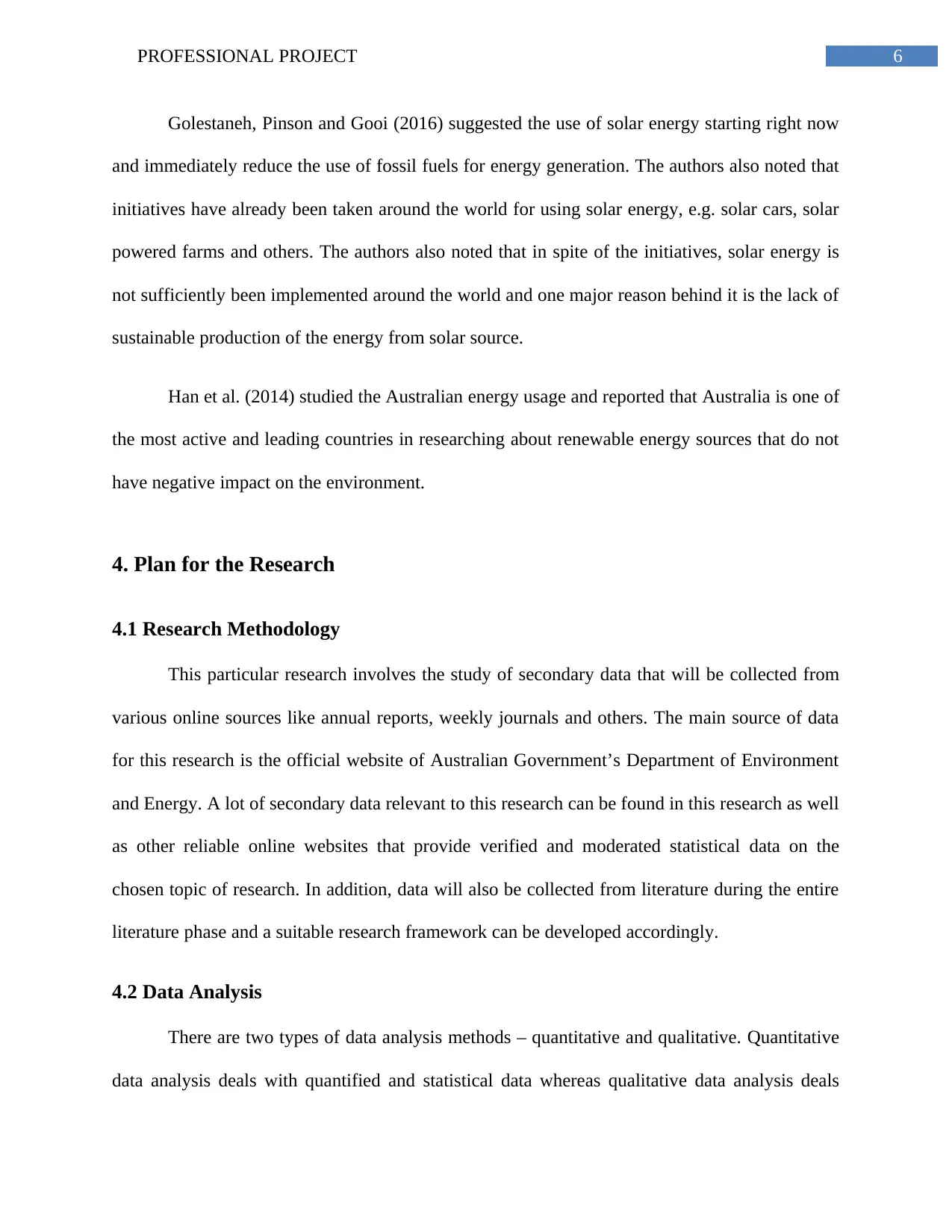
6PROFESSIONAL PROJECT
Golestaneh, Pinson and Gooi (2016) suggested the use of solar energy starting right now
and immediately reduce the use of fossil fuels for energy generation. The authors also noted that
initiatives have already been taken around the world for using solar energy, e.g. solar cars, solar
powered farms and others. The authors also noted that in spite of the initiatives, solar energy is
not sufficiently been implemented around the world and one major reason behind it is the lack of
sustainable production of the energy from solar source.
Han et al. (2014) studied the Australian energy usage and reported that Australia is one of
the most active and leading countries in researching about renewable energy sources that do not
have negative impact on the environment.
4. Plan for the Research
4.1 Research Methodology
This particular research involves the study of secondary data that will be collected from
various online sources like annual reports, weekly journals and others. The main source of data
for this research is the official website of Australian Government’s Department of Environment
and Energy. A lot of secondary data relevant to this research can be found in this research as well
as other reliable online websites that provide verified and moderated statistical data on the
chosen topic of research. In addition, data will also be collected from literature during the entire
literature phase and a suitable research framework can be developed accordingly.
4.2 Data Analysis
There are two types of data analysis methods – quantitative and qualitative. Quantitative
data analysis deals with quantified and statistical data whereas qualitative data analysis deals
Golestaneh, Pinson and Gooi (2016) suggested the use of solar energy starting right now
and immediately reduce the use of fossil fuels for energy generation. The authors also noted that
initiatives have already been taken around the world for using solar energy, e.g. solar cars, solar
powered farms and others. The authors also noted that in spite of the initiatives, solar energy is
not sufficiently been implemented around the world and one major reason behind it is the lack of
sustainable production of the energy from solar source.
Han et al. (2014) studied the Australian energy usage and reported that Australia is one of
the most active and leading countries in researching about renewable energy sources that do not
have negative impact on the environment.
4. Plan for the Research
4.1 Research Methodology
This particular research involves the study of secondary data that will be collected from
various online sources like annual reports, weekly journals and others. The main source of data
for this research is the official website of Australian Government’s Department of Environment
and Energy. A lot of secondary data relevant to this research can be found in this research as well
as other reliable online websites that provide verified and moderated statistical data on the
chosen topic of research. In addition, data will also be collected from literature during the entire
literature phase and a suitable research framework can be developed accordingly.
4.2 Data Analysis
There are two types of data analysis methods – quantitative and qualitative. Quantitative
data analysis deals with quantified and statistical data whereas qualitative data analysis deals
Paraphrase This Document
Need a fresh take? Get an instant paraphrase of this document with our AI Paraphraser
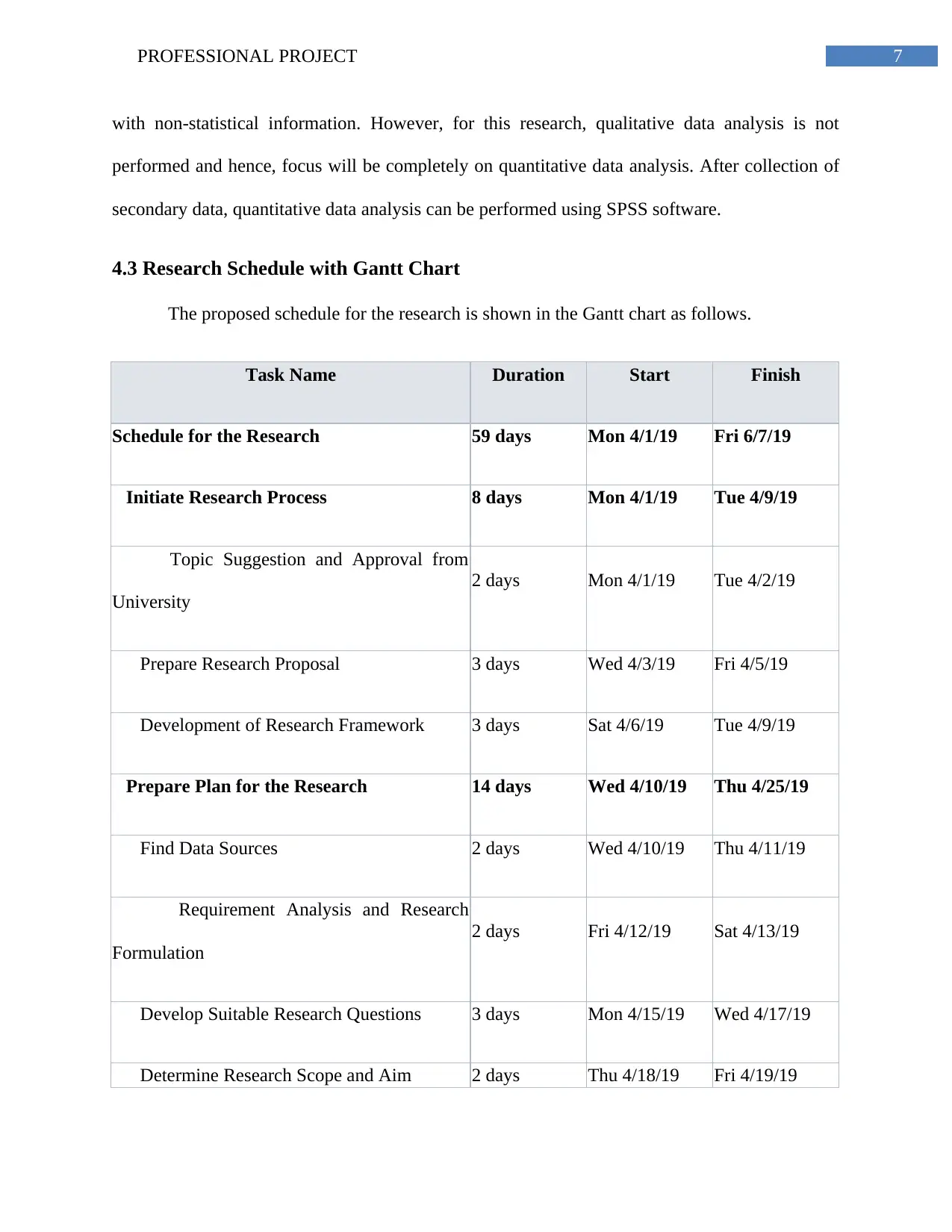
7PROFESSIONAL PROJECT
with non-statistical information. However, for this research, qualitative data analysis is not
performed and hence, focus will be completely on quantitative data analysis. After collection of
secondary data, quantitative data analysis can be performed using SPSS software.
4.3 Research Schedule with Gantt Chart
The proposed schedule for the research is shown in the Gantt chart as follows.
Task Name Duration Start Finish
Schedule for the Research 59 days Mon 4/1/19 Fri 6/7/19
Initiate Research Process 8 days Mon 4/1/19 Tue 4/9/19
Topic Suggestion and Approval from
University
2 days Mon 4/1/19 Tue 4/2/19
Prepare Research Proposal 3 days Wed 4/3/19 Fri 4/5/19
Development of Research Framework 3 days Sat 4/6/19 Tue 4/9/19
Prepare Plan for the Research 14 days Wed 4/10/19 Thu 4/25/19
Find Data Sources 2 days Wed 4/10/19 Thu 4/11/19
Requirement Analysis and Research
Formulation
2 days Fri 4/12/19 Sat 4/13/19
Develop Suitable Research Questions 3 days Mon 4/15/19 Wed 4/17/19
Determine Research Scope and Aim 2 days Thu 4/18/19 Fri 4/19/19
with non-statistical information. However, for this research, qualitative data analysis is not
performed and hence, focus will be completely on quantitative data analysis. After collection of
secondary data, quantitative data analysis can be performed using SPSS software.
4.3 Research Schedule with Gantt Chart
The proposed schedule for the research is shown in the Gantt chart as follows.
Task Name Duration Start Finish
Schedule for the Research 59 days Mon 4/1/19 Fri 6/7/19
Initiate Research Process 8 days Mon 4/1/19 Tue 4/9/19
Topic Suggestion and Approval from
University
2 days Mon 4/1/19 Tue 4/2/19
Prepare Research Proposal 3 days Wed 4/3/19 Fri 4/5/19
Development of Research Framework 3 days Sat 4/6/19 Tue 4/9/19
Prepare Plan for the Research 14 days Wed 4/10/19 Thu 4/25/19
Find Data Sources 2 days Wed 4/10/19 Thu 4/11/19
Requirement Analysis and Research
Formulation
2 days Fri 4/12/19 Sat 4/13/19
Develop Suitable Research Questions 3 days Mon 4/15/19 Wed 4/17/19
Determine Research Scope and Aim 2 days Thu 4/18/19 Fri 4/19/19
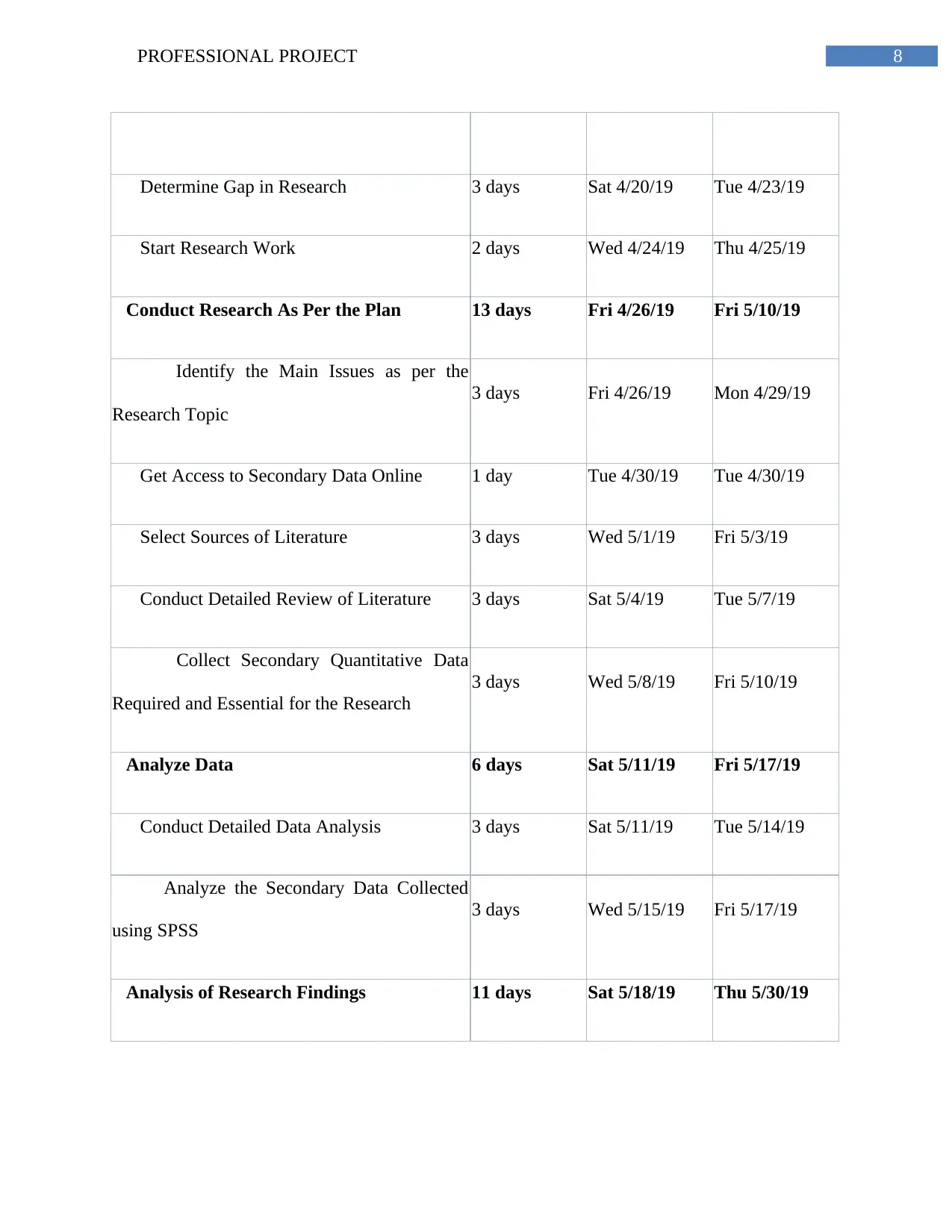
8PROFESSIONAL PROJECT
Determine Gap in Research 3 days Sat 4/20/19 Tue 4/23/19
Start Research Work 2 days Wed 4/24/19 Thu 4/25/19
Conduct Research As Per the Plan 13 days Fri 4/26/19 Fri 5/10/19
Identify the Main Issues as per the
Research Topic
3 days Fri 4/26/19 Mon 4/29/19
Get Access to Secondary Data Online 1 day Tue 4/30/19 Tue 4/30/19
Select Sources of Literature 3 days Wed 5/1/19 Fri 5/3/19
Conduct Detailed Review of Literature 3 days Sat 5/4/19 Tue 5/7/19
Collect Secondary Quantitative Data
Required and Essential for the Research
3 days Wed 5/8/19 Fri 5/10/19
Analyze Data 6 days Sat 5/11/19 Fri 5/17/19
Conduct Detailed Data Analysis 3 days Sat 5/11/19 Tue 5/14/19
Analyze the Secondary Data Collected
using SPSS
3 days Wed 5/15/19 Fri 5/17/19
Analysis of Research Findings 11 days Sat 5/18/19 Thu 5/30/19
Determine Gap in Research 3 days Sat 4/20/19 Tue 4/23/19
Start Research Work 2 days Wed 4/24/19 Thu 4/25/19
Conduct Research As Per the Plan 13 days Fri 4/26/19 Fri 5/10/19
Identify the Main Issues as per the
Research Topic
3 days Fri 4/26/19 Mon 4/29/19
Get Access to Secondary Data Online 1 day Tue 4/30/19 Tue 4/30/19
Select Sources of Literature 3 days Wed 5/1/19 Fri 5/3/19
Conduct Detailed Review of Literature 3 days Sat 5/4/19 Tue 5/7/19
Collect Secondary Quantitative Data
Required and Essential for the Research
3 days Wed 5/8/19 Fri 5/10/19
Analyze Data 6 days Sat 5/11/19 Fri 5/17/19
Conduct Detailed Data Analysis 3 days Sat 5/11/19 Tue 5/14/19
Analyze the Secondary Data Collected
using SPSS
3 days Wed 5/15/19 Fri 5/17/19
Analysis of Research Findings 11 days Sat 5/18/19 Thu 5/30/19
⊘ This is a preview!⊘
Do you want full access?
Subscribe today to unlock all pages.

Trusted by 1+ million students worldwide
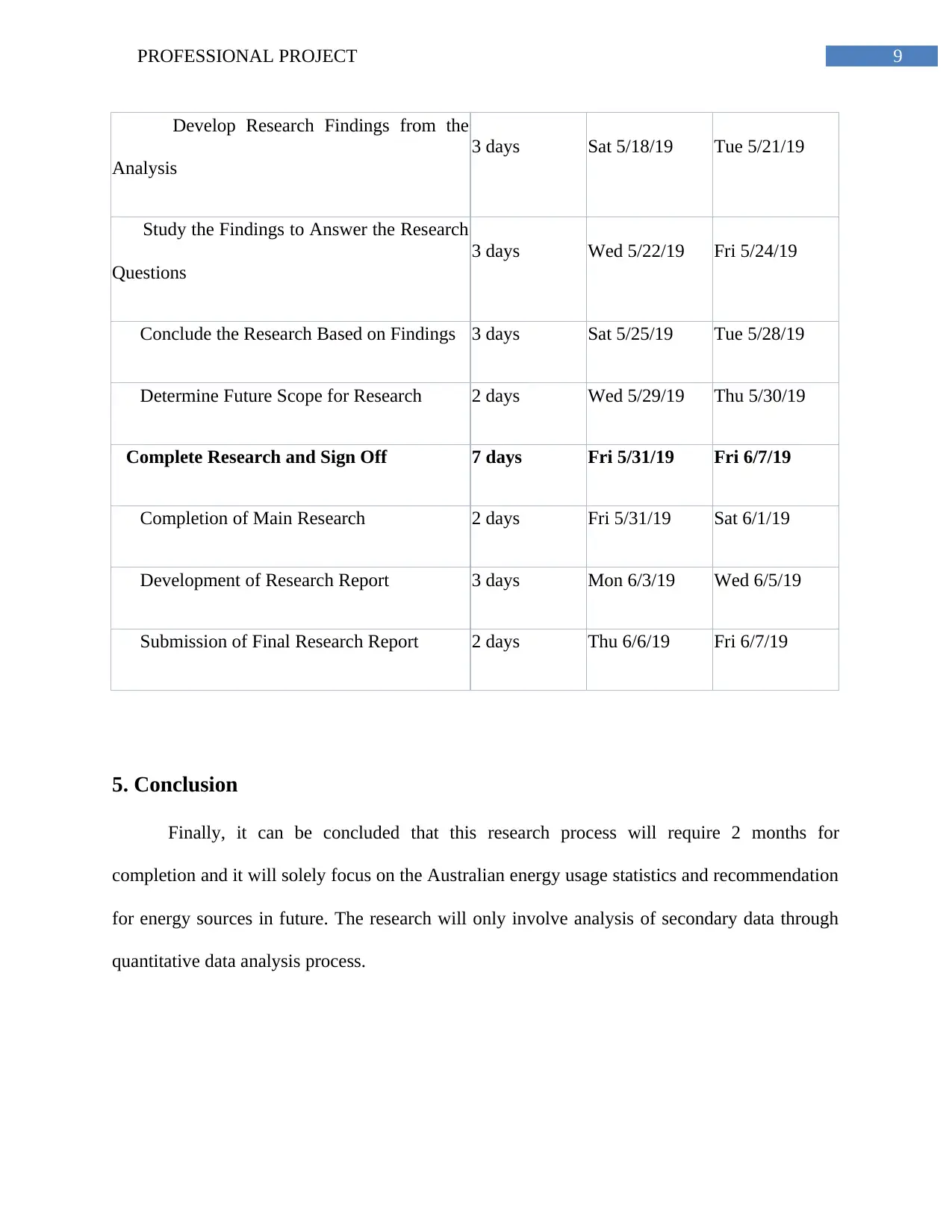
9PROFESSIONAL PROJECT
Develop Research Findings from the
Analysis
3 days Sat 5/18/19 Tue 5/21/19
Study the Findings to Answer the Research
Questions
3 days Wed 5/22/19 Fri 5/24/19
Conclude the Research Based on Findings 3 days Sat 5/25/19 Tue 5/28/19
Determine Future Scope for Research 2 days Wed 5/29/19 Thu 5/30/19
Complete Research and Sign Off 7 days Fri 5/31/19 Fri 6/7/19
Completion of Main Research 2 days Fri 5/31/19 Sat 6/1/19
Development of Research Report 3 days Mon 6/3/19 Wed 6/5/19
Submission of Final Research Report 2 days Thu 6/6/19 Fri 6/7/19
5. Conclusion
Finally, it can be concluded that this research process will require 2 months for
completion and it will solely focus on the Australian energy usage statistics and recommendation
for energy sources in future. The research will only involve analysis of secondary data through
quantitative data analysis process.
Develop Research Findings from the
Analysis
3 days Sat 5/18/19 Tue 5/21/19
Study the Findings to Answer the Research
Questions
3 days Wed 5/22/19 Fri 5/24/19
Conclude the Research Based on Findings 3 days Sat 5/25/19 Tue 5/28/19
Determine Future Scope for Research 2 days Wed 5/29/19 Thu 5/30/19
Complete Research and Sign Off 7 days Fri 5/31/19 Fri 6/7/19
Completion of Main Research 2 days Fri 5/31/19 Sat 6/1/19
Development of Research Report 3 days Mon 6/3/19 Wed 6/5/19
Submission of Final Research Report 2 days Thu 6/6/19 Fri 6/7/19
5. Conclusion
Finally, it can be concluded that this research process will require 2 months for
completion and it will solely focus on the Australian energy usage statistics and recommendation
for energy sources in future. The research will only involve analysis of secondary data through
quantitative data analysis process.
Paraphrase This Document
Need a fresh take? Get an instant paraphrase of this document with our AI Paraphraser
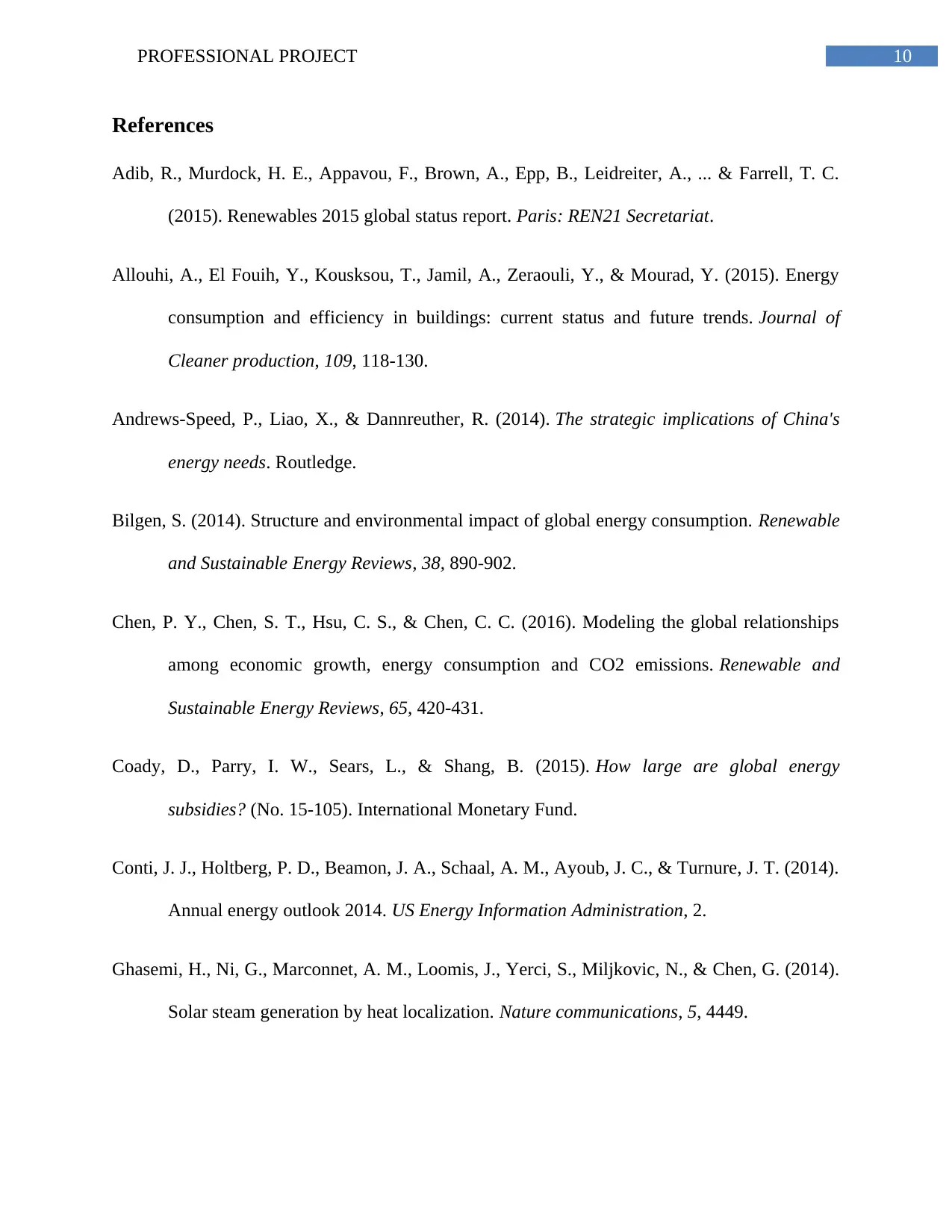
10PROFESSIONAL PROJECT
References
Adib, R., Murdock, H. E., Appavou, F., Brown, A., Epp, B., Leidreiter, A., ... & Farrell, T. C.
(2015). Renewables 2015 global status report. Paris: REN21 Secretariat.
Allouhi, A., El Fouih, Y., Kousksou, T., Jamil, A., Zeraouli, Y., & Mourad, Y. (2015). Energy
consumption and efficiency in buildings: current status and future trends. Journal of
Cleaner production, 109, 118-130.
Andrews-Speed, P., Liao, X., & Dannreuther, R. (2014). The strategic implications of China's
energy needs. Routledge.
Bilgen, S. (2014). Structure and environmental impact of global energy consumption. Renewable
and Sustainable Energy Reviews, 38, 890-902.
Chen, P. Y., Chen, S. T., Hsu, C. S., & Chen, C. C. (2016). Modeling the global relationships
among economic growth, energy consumption and CO2 emissions. Renewable and
Sustainable Energy Reviews, 65, 420-431.
Coady, D., Parry, I. W., Sears, L., & Shang, B. (2015). How large are global energy
subsidies? (No. 15-105). International Monetary Fund.
Conti, J. J., Holtberg, P. D., Beamon, J. A., Schaal, A. M., Ayoub, J. C., & Turnure, J. T. (2014).
Annual energy outlook 2014. US Energy Information Administration, 2.
Ghasemi, H., Ni, G., Marconnet, A. M., Loomis, J., Yerci, S., Miljkovic, N., & Chen, G. (2014).
Solar steam generation by heat localization. Nature communications, 5, 4449.
References
Adib, R., Murdock, H. E., Appavou, F., Brown, A., Epp, B., Leidreiter, A., ... & Farrell, T. C.
(2015). Renewables 2015 global status report. Paris: REN21 Secretariat.
Allouhi, A., El Fouih, Y., Kousksou, T., Jamil, A., Zeraouli, Y., & Mourad, Y. (2015). Energy
consumption and efficiency in buildings: current status and future trends. Journal of
Cleaner production, 109, 118-130.
Andrews-Speed, P., Liao, X., & Dannreuther, R. (2014). The strategic implications of China's
energy needs. Routledge.
Bilgen, S. (2014). Structure and environmental impact of global energy consumption. Renewable
and Sustainable Energy Reviews, 38, 890-902.
Chen, P. Y., Chen, S. T., Hsu, C. S., & Chen, C. C. (2016). Modeling the global relationships
among economic growth, energy consumption and CO2 emissions. Renewable and
Sustainable Energy Reviews, 65, 420-431.
Coady, D., Parry, I. W., Sears, L., & Shang, B. (2015). How large are global energy
subsidies? (No. 15-105). International Monetary Fund.
Conti, J. J., Holtberg, P. D., Beamon, J. A., Schaal, A. M., Ayoub, J. C., & Turnure, J. T. (2014).
Annual energy outlook 2014. US Energy Information Administration, 2.
Ghasemi, H., Ni, G., Marconnet, A. M., Loomis, J., Yerci, S., Miljkovic, N., & Chen, G. (2014).
Solar steam generation by heat localization. Nature communications, 5, 4449.
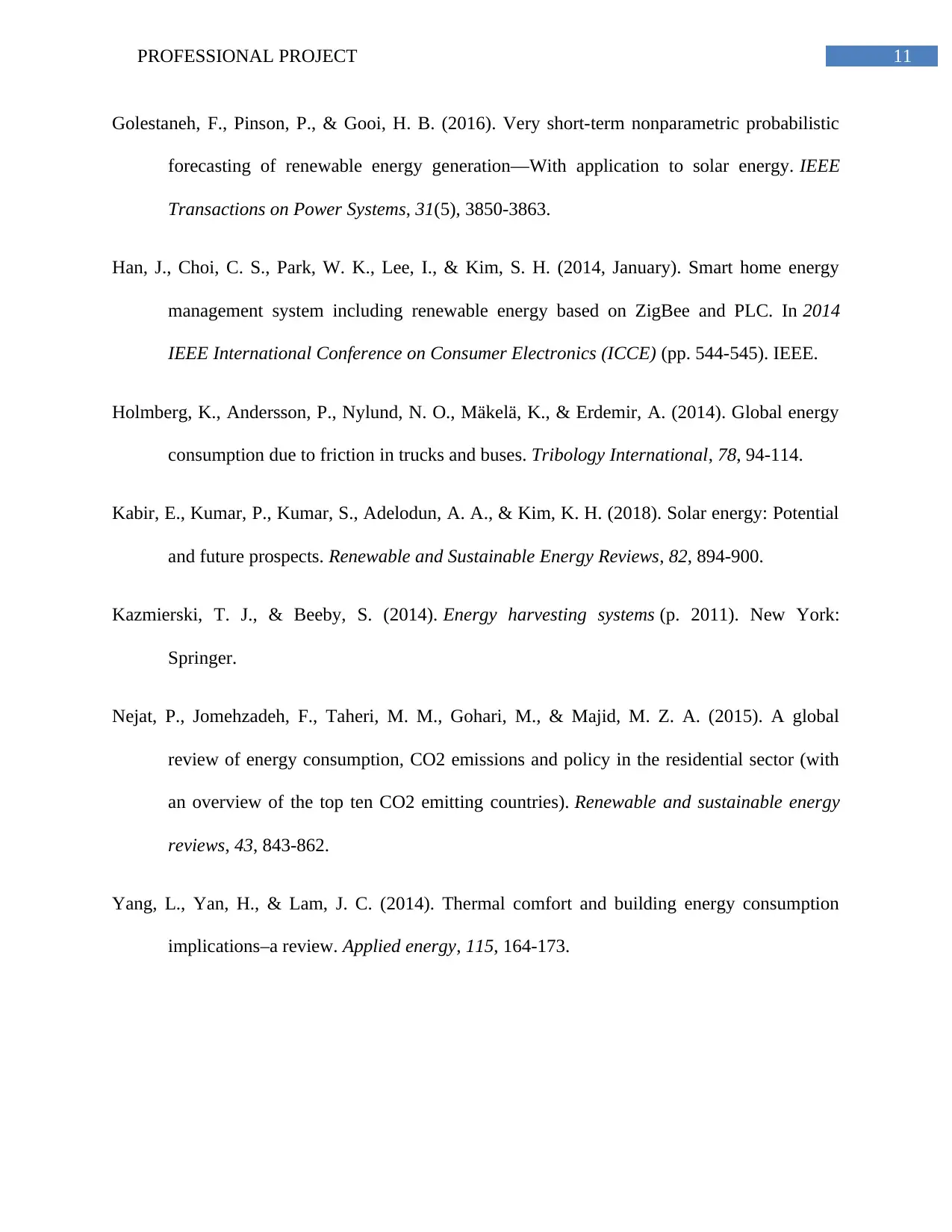
11PROFESSIONAL PROJECT
Golestaneh, F., Pinson, P., & Gooi, H. B. (2016). Very short-term nonparametric probabilistic
forecasting of renewable energy generation—With application to solar energy. IEEE
Transactions on Power Systems, 31(5), 3850-3863.
Han, J., Choi, C. S., Park, W. K., Lee, I., & Kim, S. H. (2014, January). Smart home energy
management system including renewable energy based on ZigBee and PLC. In 2014
IEEE International Conference on Consumer Electronics (ICCE) (pp. 544-545). IEEE.
Holmberg, K., Andersson, P., Nylund, N. O., Mäkelä, K., & Erdemir, A. (2014). Global energy
consumption due to friction in trucks and buses. Tribology International, 78, 94-114.
Kabir, E., Kumar, P., Kumar, S., Adelodun, A. A., & Kim, K. H. (2018). Solar energy: Potential
and future prospects. Renewable and Sustainable Energy Reviews, 82, 894-900.
Kazmierski, T. J., & Beeby, S. (2014). Energy harvesting systems (p. 2011). New York:
Springer.
Nejat, P., Jomehzadeh, F., Taheri, M. M., Gohari, M., & Majid, M. Z. A. (2015). A global
review of energy consumption, CO2 emissions and policy in the residential sector (with
an overview of the top ten CO2 emitting countries). Renewable and sustainable energy
reviews, 43, 843-862.
Yang, L., Yan, H., & Lam, J. C. (2014). Thermal comfort and building energy consumption
implications–a review. Applied energy, 115, 164-173.
Golestaneh, F., Pinson, P., & Gooi, H. B. (2016). Very short-term nonparametric probabilistic
forecasting of renewable energy generation—With application to solar energy. IEEE
Transactions on Power Systems, 31(5), 3850-3863.
Han, J., Choi, C. S., Park, W. K., Lee, I., & Kim, S. H. (2014, January). Smart home energy
management system including renewable energy based on ZigBee and PLC. In 2014
IEEE International Conference on Consumer Electronics (ICCE) (pp. 544-545). IEEE.
Holmberg, K., Andersson, P., Nylund, N. O., Mäkelä, K., & Erdemir, A. (2014). Global energy
consumption due to friction in trucks and buses. Tribology International, 78, 94-114.
Kabir, E., Kumar, P., Kumar, S., Adelodun, A. A., & Kim, K. H. (2018). Solar energy: Potential
and future prospects. Renewable and Sustainable Energy Reviews, 82, 894-900.
Kazmierski, T. J., & Beeby, S. (2014). Energy harvesting systems (p. 2011). New York:
Springer.
Nejat, P., Jomehzadeh, F., Taheri, M. M., Gohari, M., & Majid, M. Z. A. (2015). A global
review of energy consumption, CO2 emissions and policy in the residential sector (with
an overview of the top ten CO2 emitting countries). Renewable and sustainable energy
reviews, 43, 843-862.
Yang, L., Yan, H., & Lam, J. C. (2014). Thermal comfort and building energy consumption
implications–a review. Applied energy, 115, 164-173.
⊘ This is a preview!⊘
Do you want full access?
Subscribe today to unlock all pages.

Trusted by 1+ million students worldwide
1 out of 14
Related Documents
Your All-in-One AI-Powered Toolkit for Academic Success.
+13062052269
info@desklib.com
Available 24*7 on WhatsApp / Email
![[object Object]](/_next/static/media/star-bottom.7253800d.svg)
Unlock your academic potential
Copyright © 2020–2025 A2Z Services. All Rights Reserved. Developed and managed by ZUCOL.





